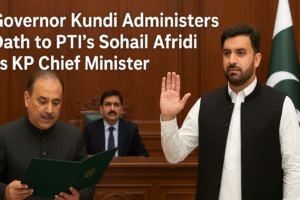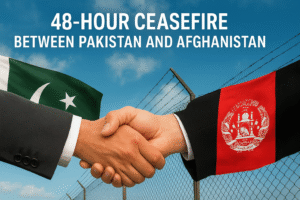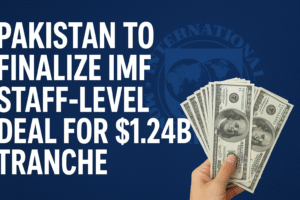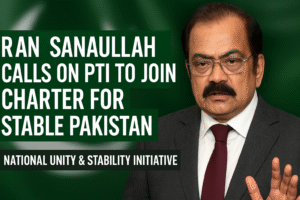PM Shehbaz, PPP Chairman Bilawal Discuss Prevailing Political Situation Over the Phone
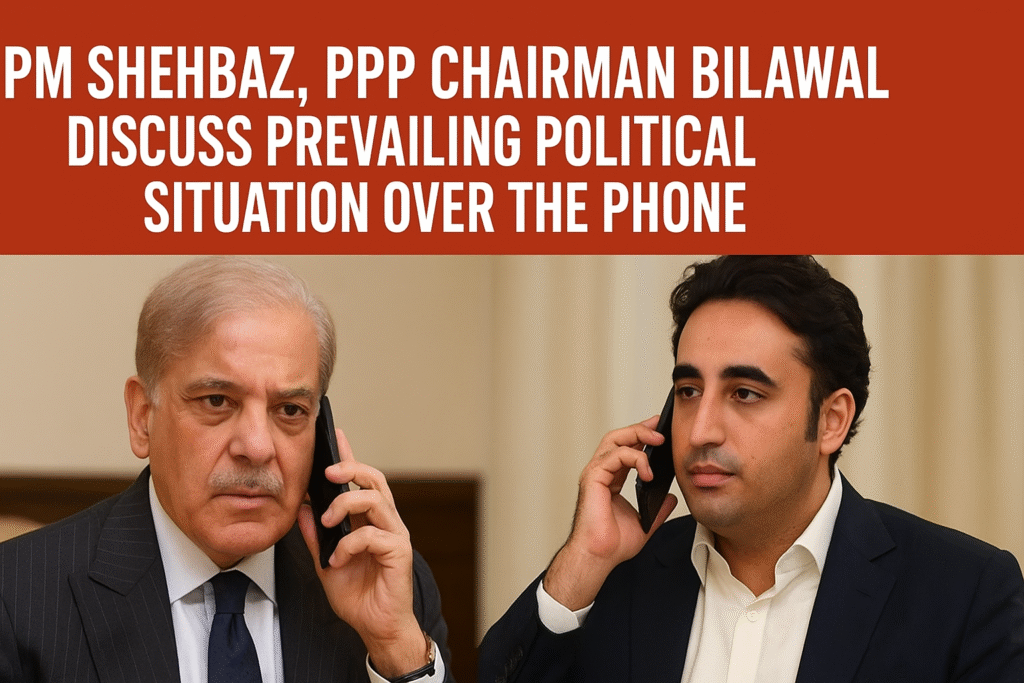
Introduction
In a politically charged atmosphere, even a single phone call can shift the direction of national politics. Pakistan’s Prime Minister Shehbaz Sharif and Pakistan People’s Party (PPP) Chairman Bilawal Bhutto Zardari held a crucial telephonic conversation to discuss the prevailing political situation, flood relief efforts, water rights disputes, and the country’s foreign policy challenges.
This conversation, though seemingly routine, has captured nationwide attention because it arrives at a time when coalition tensions are running high, especially between the Pakistan Muslim League-Nawaz (PML-N) and PPP, the two largest parties currently sharing power. The call, reportedly cordial yet serious, represents an important step toward defusing tensions that had recently escalated through public statements, assembly walkouts, and media exchanges.
The discussion reflects the complexities of Pakistan’s coalition politics, where cooperation and confrontation often coexist. At stake is not just political stability, but also the government’s ability to respond to natural disasters, manage foreign relations, and maintain public trust. PM Shehbaz, ppp-chairmanFlood relief Pakistan 2025 Pakistan political situation Indus water rights dispute. PM Shehbaz, ppp-chairmanFlood relief Pakistan 2025 Pakistan political situation Indus water rights dispute.
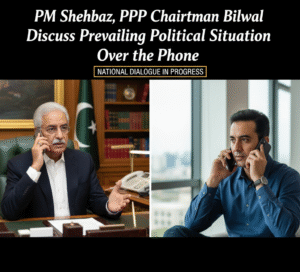
Background: The Coalition Framework
Formation of the PML-N – PPP Alliance
After the 2024 general elections, Pakistan’s political landscape was fragmented. No single party secured a simple majority, forcing major political actors to form alliances. The PML-N, led by Shehbaz Sharif, and the PPP, led by Bilawal Bhutto Zardari, joined forces to establish a coalition government at the federal level. Their shared objective was to ensure political stability, curb economic volatility, and block the return of populist unrest.
Initially, the alliance appeared pragmatic and cooperative. PPP agreed to support PML-N in forming the government but kept some distance from the federal cabinet to maintain its political identity, especially in Sindh where it governs independently. However, as months passed, differences emerged over governance style, administrative priorities, and provincial autonomy.
Tensions Building Before the Phone Call
1. Flood Relief and Disaster Management
In mid-2025, catastrophic monsoon floods struck parts of Sindh, Punjab, and Balochistan. Millions were displaced, and agricultural production suffered severe losses. The PPP accused the federal government of neglecting Sindh’s plight, arguing that federal aid distribution favored Punjab.
PML-N leaders countered by claiming that the central government had released record relief funds but faced bureaucratic bottlenecks and corruption at the provincial level. The media amplified these accusations, further widening the rift between the coalition partners.
2. The Water Rights Dispute
Another contentious issue was the Indus River water sharing dispute. Sindh alleged that Punjab was taking more than its allotted share under the provincial water accord, reducing downstream flow crucial for Sindh’s irrigation and ecology.
PPP leaders publicly raised this issue, emphasizing Sindh’s constitutional rights. Punjab’s leadership, including prominent PML-N figures, dismissed these allegations as political posturing. This exchange triggered resentment among PPP ranks and strengthened demands within Sindh for stronger provincial autonomy.
3. Sharp Public Statements
A war of words ensued. Remarks attributed to Punjab’s leadership—particularly Maryam Nawaz—telling PPP to “mind its own business” over water rights, inflamed tensions. PPP ministers responded by accusing Punjab of “institutional arrogance” and “provincial favoritism.”
The situation reached a boiling point when PPP legislators walked out of the National Assembly and Senate in protest. This symbolic act exposed deep cracks in coalition harmony and sparked speculation that PPP might withdraw support.
4. Mediation by Senior Figures
Recognizing the risk of a full-blown rift, President Asif Ali Zardari—also co-chairman of the PPP—stepped in to mediate. Behind closed doors, Interior Minister Mohsin Naqvi and senior PML-N advisers attempted to calm the situation. It was in this tense environment that Prime Minister Shehbaz Sharif and Chairman Bilawal Bhutto Zardari spoke over the phone—a move seen as both conciliatory and strategic.
Details of the Phone Conversation
According to official statements, the two leaders discussed several critical issues:
-
The overall political situation and coalition dynamics
-
The ongoing flood relief operations and rehabilitation of displaced citizens
-
Water management and interprovincial coordination
-
Foreign policy matters, including Pakistan’s relations with neighboring countries and international partners
Though details of the conversation remain private, sources close to both parties confirm that the tone was constructive. Both leaders reportedly reaffirmed their commitment to coalition stability, acknowledging that political unity was essential amid Pakistan’s economic and environmental crises.
Dissecting the Core Issues
1. Flood Relief and Public Accountability
Pakistan faces recurring floods due to climate change and poor infrastructure. The 2025 floods were particularly devastating in Sindh and Balochistan. Roads, schools, and hospitals were damaged, while thousands of families lost homes and livelihoods.
PPP accused federal authorities of delaying funds and prioritizing Punjab. The PML-N government rejected the claim, arguing that relief allocation was based on need assessments, not politics. Both sides traded statistics to justify their positions.
The phone call between Shehbaz and Bilawal reportedly aimed to create a joint flood recovery framework—one that would ensure transparency and prevent duplication of efforts. It is believed that they agreed on enhanced federal-provincial coordination, the establishment of joint monitoring committees, and third-party audits to track aid utilization.
2. Water Rights and the Indus Dispute
The Indus River dispute has been a recurring source of interprovincial tension since Pakistan’s inception. Sindh has long accused Punjab of using more than its fair share of water, leaving southern regions dry. Punjab, however, argues that technical and hydrological factors, not political bias, explain variations in water distribution.
During the phone call, both leaders reportedly discussed reviving the Indus River System Authority (IRSA) as a neutral arbiter. The goal is to implement data transparency through real-time water flow monitoring systems.
Bilawal emphasized Sindh’s need for fair water allocation, while Shehbaz assured federal cooperation and urged technical, not political, resolution. The exchange was said to be calm, signaling a willingness to replace accusations with institutional mechanisms.
3. Foreign Policy and Pakistan’s Global Standing
The conversation also touched upon foreign policy challenges. Pakistan’s diplomacy in 2025 faces multiple fronts: strained ties with Afghanistan, cautious engagement with India, balancing relations between China and the U.S., and managing Gulf investments.
Both Shehbaz and Bilawal agreed that domestic unity is crucial for a consistent foreign policy. They discussed upcoming visits, diplomatic missions, and humanitarian aid coordination. A divided government, they recognized, weakens Pakistan’s credibility abroad.
4. Political Communication and Coalition Management
Another issue reportedly discussed was media discipline. Both sides acknowledged that public disagreements erode confidence. They agreed to restrain party spokespeople from issuing inflammatory statements and to rely on official channels for communication.
Such an understanding could pave the way for better crisis management and policy continuity, even as the two parties maintain their distinct political identities.
Underlying Tensions and Risks
Despite cordial gestures, the coalition’s underlying tensions remain deep.
-
Ideological Differences: PPP’s social-democratic approach contrasts with PML-N’s pro-business pragmatism.
-
Provincial Rivalry: Punjab-Sindh dynamics influence nearly every federal decision.
-
Leadership Style: Shehbaz’s centralized management approach sometimes clashes with PPP’s consensus-based politics.
-
Public Perception: Both parties fear losing their voter base if perceived as submissive to the other.
Political analysts believe that while the phone call may have eased immediate tensions, it cannot substitute for structural reform in coalition management.
Political Implications of the Call
1. Message of Reconciliation
By directly engaging Bilawal, Shehbaz signaled a desire to repair communication lines. The call demonstrated that both leaders are aware of the political cost of confrontation. In times of national crisis, appearing divided could hurt their credibility and embolden the opposition.
2. Pressure from the Public and Opposition
The opposition, particularly PTI, has been closely monitoring the situation. Any visible rift between PPP and PML-N provides a political opening. The public, weary of political infighting amid inflation and disasters, expects collaboration over confrontation.
3. Strengthening of Institutional Mechanisms
The call could lead to institutional solutions such as joint parliamentary committees, relief monitoring bodies, and interprovincial councils to reduce misunderstandings. These mechanisms can transform personal reconciliation into sustainable cooperation.
Historical Context: Lessons from the Past
Pakistan’s history is replete with examples where coalition governments rose or fell over communication breakdowns.
-
In the 1990s, PPP and PML-N alternated between cooperation and confrontation, often collapsing over power-sharing disputes.
-
During the 2010-2013 PPP government, similar tensions arose with coalition partners over governance and federal funding.
-
The National Reconciliation Ordinance (NRO) period illustrated how temporary alliances can stabilize politics if dialogue is prioritized.
The latest phone call between Shehbaz and Bilawal thus continues a long tradition of telephone diplomacy, where informal communication often resolves what formal meetings cannot.
Flood Crisis: A Deeper Dive
To truly understand the stakes, it is essential to examine the scale of the 2025 floods. Pakistan received record monsoon rainfall, nearly 40% above the long-term average. Rivers overflowed, embankments broke, and thousands of villages were submerged.
The National Disaster Management Authority (NDMA) estimated billions in damages. Sindh alone faced agricultural losses worth hundreds of billions of rupees. The humanitarian toll—especially on women, children, and farmers—was severe.
The political dimension of disaster management became contentious. While both PML-N and PPP claimed credit for relief work, public sentiment turned negative amid perceptions of mismanagement and corruption. The call between the two leaders aimed to restore confidence by creating a united national response framework.
Water Politics: The Lifeblood of the Federation
The Indus River is Pakistan’s lifeline, feeding agriculture, industry, and domestic needs. The Indus Waters Accord defines provincial allocations, but climate shifts and rising demands have intensified disputes.
Sindh argues that Punjab’s construction of new canals upstream reduces its share. Punjab insists it follows legal quotas and points to technical challenges in flow measurement.
The phone call discussed reviving IRSA’s credibility through transparent data sharing and modern monitoring technology. Both leaders recognized that sustainable water management is not merely a provincial issue—it is central to national unity.
Foreign Policy Dimension
Foreign policy was another major component of the conversation. Both leaders agreed that domestic unity underpins international credibility. Key topics likely included:
-
Pakistan’s relations with Afghanistan, especially border management
-
China-Pakistan Economic Corridor (CPEC) project acceleration
-
Engagement with Gulf states for post-flood reconstruction aid
-
Balancing ties between the U.S. and China in a shifting geopolitical environment
-
Strengthening Pakistan’s narrative at global climate forums
Both Shehbaz and Bilawal share an understanding that Pakistan’s future lies in diplomacy, economic reforms, and climate resilience—not political infighting.
Mediation Efforts and the Road Ahead
Following the phone conversation, insiders suggest that President Asif Ali Zardari may continue to act as a bridge. He reportedly encouraged both leaders to maintain direct communication instead of exchanging barbs through media.
The coalition may soon form a Coordination Committee, including senior members from both parties, to oversee sensitive issues like water allocation, disaster management, and fiscal transfers.
If implemented effectively, these steps could transform a moment of tension into an opportunity for institutional maturity.
Possible Scenarios
Scenario 1: Full Reconciliation
-
Joint press conference reaffirming unity
-
Shared flood rehabilitation plan
-
Mutually agreed water management strategy
-
Improved foreign policy coordination
Scenario 2: Temporary Truce
-
Cooperation on selective issues
-
Continued undercurrents of mistrust
-
Occasional public disagreements
Scenario 3: Renewed Confrontation
-
Escalation of verbal attacks
-
PPP withdrawal from coalition support
-
Political instability leading to early elections
Observers believe the first two scenarios are most probable, as both parties understand the consequences of collapse.
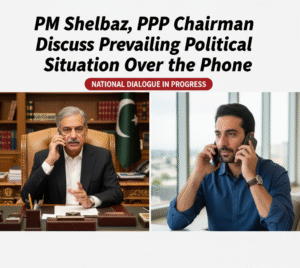
Public Sentiment and Media Reaction
Public response to the news of the phone call was largely positive. Citizens, analysts, and journalists described it as a “welcome thaw” in coalition tensions. Social media users called for continued dialogue and cooperation.
Independent observers emphasized that the government’s ability to function smoothly amid crises depends on mutual respect between coalition partners. While skepticism remains, the phone call is seen as a necessary gesture of goodwill. PM Shehbaz, ppp-chairmanFlood relief Pakistan 2025 Pakistan political situation Indus water rights dispute
Economic and Governance Stakes
The timing of this conversation is crucial. Pakistan’s economy is still recovering from external debt pressures, inflation, and fiscal deficits. Political uncertainty could undermine investor confidence and stall development projects.
Shehbaz Sharif’s reputation as an administrator and Bilawal Bhutto’s image as a progressive reformer both hinge on demonstrating that governance can rise above partisanship.
Economic experts believe that if the coalition stabilizes, Pakistan could leverage international reconstruction aid, green investment, and climate financing more effectively. PM Shehbaz, ppp-chairmanFlood relief Pakistan 2025 Pakistan political situation Indus water rights dispute
Conclusion: Dialogue as the Lifeline of Democracy
The phone call between Prime Minister Shehbaz Sharif and PPP Chairman Bilawal Bhutto Zardari may not have resolved every disagreement, but it restored something vital—communication.
In a federation as diverse and complex as Pakistan, dialogue is democracy’s oxygen. The conversation symbolizes a political maturity that the country needs in times of overlapping crises—economic, environmental, and institutional. PM Shehbaz, ppp-chairmanFlood relief Pakistan 2025 Pakistan political situation Indus water rights dispute. PM Shehbaz, ppp-chairmanFlood relief Pakistan 2025 Pakistan political situation Indus water rights dispute. PM Shehbaz, ppp-chairmanFlood relief Pakistan 2025 Pakistan political situation Indus water rights dispute.
